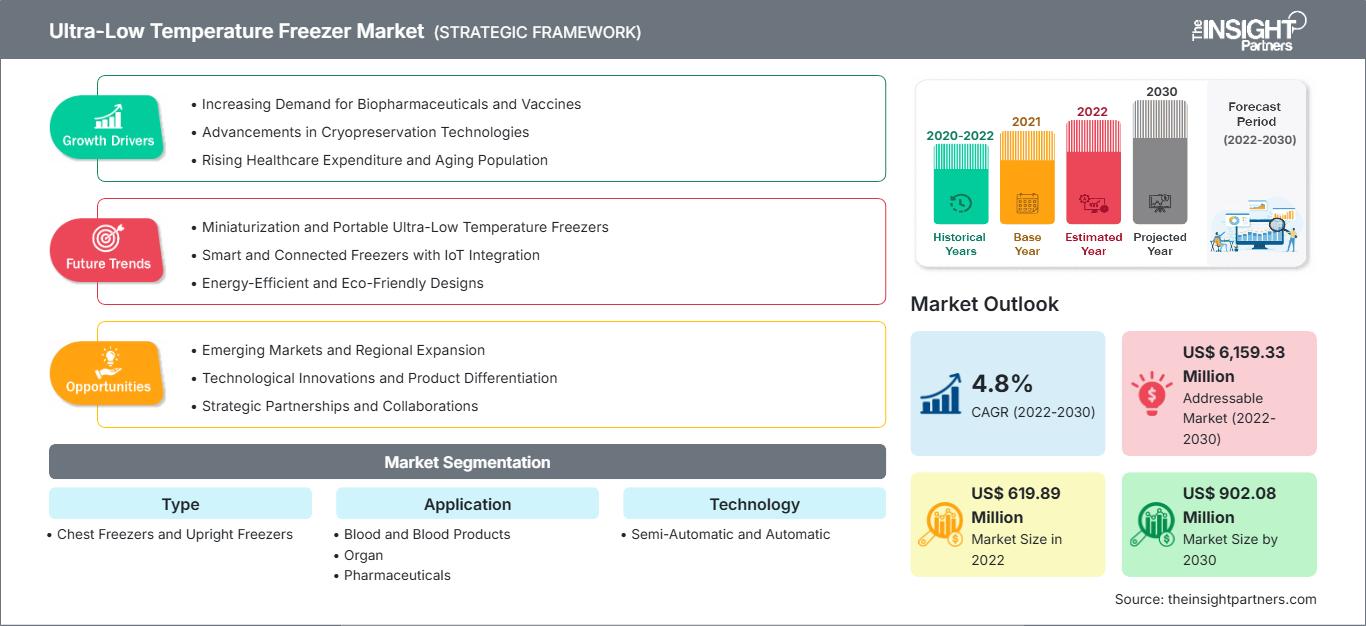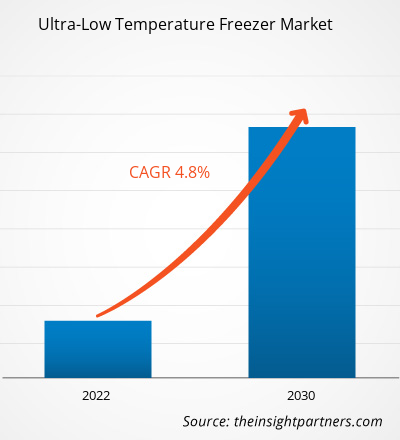[Informe de investigación] Se prevé que el mercado de congeladores de temperatura ultrabaja crezca de 619,89 millones de dólares estadounidenses en 2022 a 902,08 millones de dólares estadounidenses en 2030; se anticipa que registre una tasa de crecimiento anual compuesta (TCAC) del 4,8 % entre 2022 y 2030.
Perspectivas del mercado y opinión de los analistas:
El mercado de congeladores de ultra baja temperatura está en expansión debido al aumento de las actividades de I+D para el desarrollo de nuevos fármacos, la creciente demanda de sangre y componentes sanguíneos, y el mayor apoyo gubernamental a la investigación y los ensayos clínicos. Además, la disponibilidad de productos avanzados por parte de los fabricantes impulsa este crecimiento. Los congeladores verticales Thermo Scientific Revco RLE de -86 °C están disponibles en cinco capacidades, con un espacio de almacenamiento de entre 300 y 700 cajas de 2 pulgadas. Estos congeladores ofrecen un rendimiento térmico, seguridad y protección excepcionales.
Factores de crecimiento y desafíos:
Las muestras para investigación biológica requieren almacenamiento a temperaturas inferiores a -80 °C, es decir, a temperaturas ultrabajas (ULT). La tecnología ULT ofrece una alternativa a la refrigeración convencional basada en compresores, mejorando continuamente a medida que se profundiza su conocimiento. Entre los productos innovadores de Haier Biomedical se incluyen congeladores ULT con tecnología inteligente de conversión de frecuencia, que presentan un consumo energético sin precedentes de tan solo 8,2 kWh/día y una capacidad de 829 L/29,2 ft³. En octubre de 2022, Thermo Fisher Scientific incorporó a su catálogo de congeladores ecológicos de temperatura ultrabaja (ULT) el congelador horizontal Thermo Scientific TDE Series de -80 °C. Este congelador, alimentado por sistemas de hidrocarburos H-drive, optimiza el rendimiento necesario para la investigación crítica sin comprometer la sostenibilidad. En junio de 2023, el congelador vertical ultracongelado Stirling de BioLife Solutions, clase ISO 6, fue aprobado para aplicaciones en salas blancas de acuerdo con las Buenas Prácticas de Fabricación (BPF) pertinentes, sin comprometer el rendimiento del almacenamiento biológico ni la limpieza del entorno.
Los congeladores de ultra baja temperatura (ULT) para el almacenamiento de muestras son un componente crucial en numerosos biobancos, clínicas y laboratorios a nivel mundial. Estas unidades permiten almacenar una amplia variedad de muestras biológicas, incluyendo ADN, ARN, proteínas y extractos celulares. Requieren un suministro eléctrico constante para mantener bajas temperaturas. El Instituto Internacional para Laboratorios Sostenibles afirmó que un congelador ULT promedio consume la misma cantidad de energía (20 kWh por día) que una vivienda unifamiliar. Dado que los laboratorios y centros de investigación suelen operar decenas de estas unidades simultáneamente, los costos operativos y energéticos pueden ser determinantes en la decisión del usuario. El costo promedio de operación de un congelador ULT mecánico vertical puede variar entre US$ 750 (£570) y US$ 1000 (£750) anuales, dependiendo de factores como el tamaño y el rango de temperatura. El mantenimiento regular, incluyendo la descongelación, puede reducir considerablemente este costo. Además, las cifras mencionadas sobre los congeladores ULT no incluyen el costo adicional de los sistemas de climatización (HVAC) ni la extracción del aire caliente. Por lo tanto, los altos costos asociados con los congeladores ULT se convierten en una seria preocupación para los laboratorios e instalaciones de almacenamiento con presupuestos ajustados.
Obtendrá personalización gratuita de cualquier informe, incluyendo partes de este informe, análisis a nivel de país y paquetes de datos de Excel. Además, podrá aprovechar excelentes ofertas y descuentos para empresas emergentes y universidades.
Mercado de congeladores de temperatura ultrabaja: Perspectivas estratégicas

-
Obtenga las principales tendencias clave del mercado que se describen en este informe.Esta muestra GRATUITA incluirá análisis de datos, que abarcarán desde tendencias de mercado hasta estimaciones y pronósticos.
Segmentación y alcance del informe:
El mercado de congeladores de temperatura ultrabaja se segmenta según el tipo, la aplicación, la tecnología y la geografía. Por aplicación, se divide en sangre y hemoderivados, órganos, productos farmacéuticos, investigación forense y genómica, y otros. Por tecnología, se divide en automáticos y semiautomáticos.
Según la geografía, el mercado de congeladores de temperatura ultrabaja se segmenta en América del Norte (EE. UU., Canadá y México), Europa (Reino Unido, Alemania, Francia, Italia, España, Rusia y resto de Europa), Asia Pacífico (China, Japón, India, Corea del Sur, Australia, Sudeste Asiático y resto de Asia Pacífico), Oriente Medio y África (Emiratos Árabes Unidos, Arabia Saudita, Sudáfrica y resto de Oriente Medio y África) y América del Sur y Central (Brasil, Argentina y resto de América del Sur y Central).
Análisis segmentario:
El mercado de congeladores de ultrabaja temperatura, según su tipo, se divide en congeladores horizontales y verticales. En 2022, el segmento de congeladores verticales ostentó una mayor cuota de mercado, y se prevé que registre una mayor tasa de crecimiento anual compuesto (TCAC) durante el período 2022-2030. El crecimiento proyectado del mercado de congeladores verticales se atribuye a ventajas como su diseño compacto, la facilidad de organización y la disponibilidad de diversas características de seguridad. Además, la creciente adopción de estos congeladores gracias a los avances tecnológicos, que permiten una mejor supervisión de las operaciones y facilitan su uso, impulsará el crecimiento del mercado de congeladores verticales de ultrabaja temperatura durante el período de pronóstico.
Análisis regional:
Según la geografía, el mercado de congeladores de ultra baja temperatura se segmenta en Norteamérica, Europa, Asia Pacífico, Oriente Medio y África, y Sudamérica y Centroamérica. Norteamérica es el principal contribuyente al crecimiento del mercado global de congeladores de ultra baja temperatura. Se prevé que Asia Pacífico registre la mayor tasa de crecimiento anual compuesto (TCAC) en este mercado durante el período 2022-2030. El crecimiento del mercado de congeladores de ultra baja temperatura en Estados Unidos se debe principalmente al aumento de la prevalencia del cáncer de pulmón, los lanzamientos de productos y las iniciativas gubernamentales. La creciente demanda de biobancos ofrece un potencial transformador para los sistemas sanitarios y económicos de Estados Unidos. Sin embargo, la necesidad de comprender las enfermedades, descubrir fármacos y desarrollar biobancos impulsa aún más su desarrollo inmediato. Además, la investigación en biobancos proporciona nuevos conocimientos sobre el componente genético de las enfermedades humanas, lo que permite desarrollar un enfoque automatizado y más personalizado de la atención médica. Asimismo, varios actores del mercado estadounidense se centran en ofrecer una cartera diversificada e innovadora de productos y servicios de biobancos diseñados para acelerar descubrimientos que salvan vidas. El creciente número de actividades comerciales entre los participantes del mercado está contribuyendo dinámicamente a su crecimiento. En noviembre de 2020, los hospitales de varios estados y ciudades de EE. UU. tenían dificultades para adquirir congeladores de ultra baja temperatura que pudieran almacenar de forma segura la vacuna contra la COVID-19 de Pfizer Inc. (PFE.N), haciendo caso omiso de las recomendaciones de los Centros para el Control y la Prevención de Enfermedades (CDC) de EE. UU. de posponer su compra.
Perspectivas regionales del mercado de congeladores de temperatura ultrabaja
Los analistas de The Insight Partners han explicado en detalle las tendencias regionales y los factores que influyen en el mercado de congeladores de ultrabaja temperatura durante el período de previsión. Esta sección también analiza los segmentos y la geografía del mercado de congeladores de ultrabaja temperatura en Norteamérica, Europa, Asia Pacífico, Oriente Medio y África, y Sudamérica y Centroamérica.
Alcance del informe de mercado de congeladores de temperatura ultrabaja
| Atributo del informe | Detalles |
|---|---|
| Tamaño del mercado en 2022 | 619,89 millones de dólares estadounidenses |
| Tamaño del mercado para 2030 | US$ 902,08 millones |
| Tasa de crecimiento anual compuesto global (2022 - 2030) | 4,8% |
| Datos históricos | 2020-2022 |
| período de previsión | 2022-2030 |
| Segmentos cubiertos |
Por tipo
|
| Regiones y países cubiertos |
América del norte
|
| Líderes del mercado y perfiles de empresas clave |
|
Densidad de los actores del mercado de congeladores de temperatura ultrabaja: comprensión de su impacto en la dinámica empresarial
El mercado de congeladores de temperatura ultrabaja está creciendo rápidamente, impulsado por la creciente demanda de los usuarios finales debido a factores como la evolución de las preferencias de los consumidores, los avances tecnológicos y una mayor conciencia de los beneficios del producto. A medida que aumenta la demanda, las empresas amplían su oferta, innovan para satisfacer las necesidades de los consumidores y aprovechan las nuevas tendencias, lo que impulsa aún más el crecimiento del mercado.

- Obtenga una visión general de los principales actores del mercado de congeladores de temperatura ultrabaja.
Desarrollos de la industria y oportunidades futuras:
A continuación se enumeran diversas iniciativas de los principales actores que operan en el mercado de congeladores de temperatura ultrabaja:
- En mayo de 2023, PHC Corporation of North America (PHCNA) anunció que el congelador de ultrabaja temperatura VIP ECO SMART de la marca PHCbi había recibido el prestigioso premio al Producto Nuevo Sobresaliente de 2023 otorgado por la Sociedad Internacional de Repositorios Biológicos y Ambientales (ISBER). El producto está diseñado para su uso en diversas instalaciones, como universidades, centros médicos y empresas farmacéuticas.
- En febrero de 2023, PHC Corporation of North America (PHCNA) lanzó la serie de congeladores de ultra baja temperatura VIP ECO SMART de la marca PHCbi. Esta nueva serie se basa en congeladores de ultra baja temperatura innovadores y fiables que ofrecen un mayor ahorro de energía, además de mejorar la seguridad y la facilidad de uso.
Panorama competitivo y empresas clave:
Thermo Fisher Scientific Inc., Godrej Group, Haier Group Corporation, Blue Star Limited, Helmer Scientific Inc., PHC Holdings, BioLife Solutions Inc., Eppendorf SE, Meling Biomedical y Arctiko se encuentran entre los principales actores del mercado de congeladores de ultra baja temperatura. Estas empresas se centran en el lanzamiento de nuevos productos y la expansión geográfica para satisfacer la creciente demanda mundial y ampliar su gama de productos especializados. Su presencia global les permite atender a una amplia base de clientes, lo que facilita la expansión del mercado.
- Análisis histórico (2 años), año base, pronóstico (7 años) con CAGR
- Análisis PEST y FODA
- Tamaño del mercado, valor/volumen: global, regional y nacional
- Industria y panorama competitivo
- Conjunto de datos de Excel
Informes recientes
Informes relacionados
Testimonios
Razón para comprar
- Toma de decisiones informada
- Comprensión de la dinámica del mercado
- Análisis competitivo
- Información sobre clientes
- Pronósticos del mercado
- Mitigación de riesgos
- Planificación estratégica
- Justificación de la inversión
- Identificación de mercados emergentes
- Mejora de las estrategias de marketing
- Impulso de la eficiencia operativa
- Alineación con las tendencias regulatorias






















 Obtenga una muestra gratuita para - Mercado de congeladores de temperatura ultrabaja
Obtenga una muestra gratuita para - Mercado de congeladores de temperatura ultrabaja